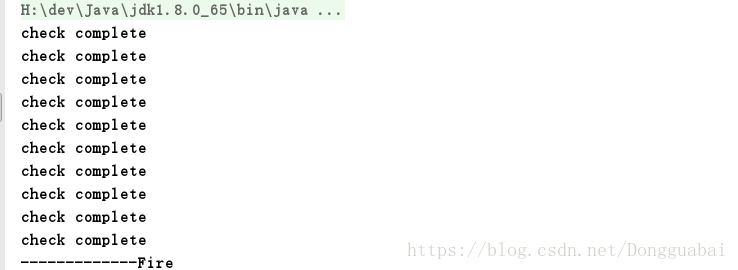CountDownLatch允许一个或多个线程等待其他线程完成操作。
比如如果要实现一个这样的功能:要让主线程等待所有线程完成自己的操作后再执行,最简单的做法是使用join()方法(可参看https://blog.csdn.net/Dongguabai/article/details/82255331)。这是一个比较简单简单的例子:
package dgb.test.concurrent;
/**
* @author Dongguabai
* @date 2018/9/24 12:06
*/
public class JoinTest2 {
public static void main(String[] args) throws InterruptedException {
System.out.println("主线程开始执行");
Thread thread1 = new Thread(() -> {
System.out.println("thread--1开始执行!");
try {
Thread.sleep(2000);
} catch (InterruptedException e) {
e.printStackTrace();
}
System.out.println("thread--1执行完成!");
});
Thread thread2 = new Thread(() -> {
System.out.println("thread--2开始执行!");
try {
Thread.sleep(3000);
} catch (InterruptedException e) {
e.printStackTrace();
}
System.out.println("thread--2执行完成!");
});
thread1.start();
thread2.start();
thread1.join();
thread2.join();
System.out.println("主线程结束执行");
}
}

join()方法的原理之前也分析过了,本质就是在当前线程中调用了另一个线程的wait()方法,然后不停检查join线程是否存活,如果join线程存活则让当前线程永远等待。其中,wait(0)表示永远等下去。直到join线程中止后,线程的this.notifyAll()方法会被调用,调用notifyAll()方法是在JVM里实现的,所以在JDK里看不到。
其实在JUC中有一个更好用的工具,就是CountDownLatch。
CountDownLatch的构造函数接收一个int类型的参数作为计数器,如果你想等待N个点完成,这里就传入N。当我们调用CountDownLatch的countDown方法时,N就会减1,CountDownLatch的await方法会阻塞当前线程,直到N变成零。由于countDown方法可以用在任何地方,所以这里说的N个点,可以是N个线程,也可以是1个线程里的N个执行步骤。用在多个线程时,只需要把这个CountDownLatch的引用传递到线程里即可。如果有某个操作执行得比较慢,我们不可能让主线程一直等待,所以可以使用另外一个带指定时间的await方法——await(long time,TimeUnit unit),这个方法等待特定时间后,就会不再阻塞当前线程。join也有类似的方法。
要注意的是:计数器必须大于等于0,只是等于0时候,计数器就是零,调用await方法时不会阻塞当前线程。CountDownLatch不可能重新初始化或者修改CountDownLatch对象的内部计数器的值(如果想实现重置功能,可以使用JUC中的另一个工具CyclicBarrier,这个在后面会介绍)。一个线程调用countDown方法happen-before,另外一个线程调用await方法。
下面是几个简单的例子:
package dgb.test.concurrent;
import java.util.Random;
import java.util.concurrent.CountDownLatch;
import java.util.concurrent.ExecutorService;
import java.util.concurrent.Executors;
/**
* @author Dongguabai
* @date 2018/9/24 11:46
*/
public class CountDownLaunthDemo implements Runnable{
static int count = 10;
static CountDownLatch end = new CountDownLatch(count);
static CountDownLaunthDemo demo = new CountDownLaunthDemo();
@Override
public void run() {
try {
Thread.sleep(new Random().nextInt(10)*1000);
System.out.println("check complete");
end.countDown();
} catch (InterruptedException e) {
e.printStackTrace();
}
}
public static void main(String[] args) throws InterruptedException {
ExecutorService exec = Executors.newFixedThreadPool(count);
for (int i = 0; i < count; i++) {
exec.submit(demo);
}
end.await();
System.out.println("-------------Fire");
exec.shutdownNow();
}
}

public class TestBingfa {
//发送请求的url地址
private final String url = "http://localhost:8085/bda-search";
//模拟的并发量
private static final int BINGFA = 199;
private static CountDownLatch cdl = new CountDownLatch(BINGFA);
public static void main(String[] args) {
for (int i = 0; i < BINGFA; i++) {
new Thread(new UserRequest()).start();
cdl.countDown();
}
}
public static class UserRequest implements Runnable{
@Override
public void run() {
try {
cdl.await();
} catch (Exception e) {
e.printStackTrace();
}
//使用工具类发送http请求
String json2 = HttpClientUtil.sendHttpPostJson(url, getJson());
System.out.println(new Date().getTime()+"::"+json2);
}
}
//发送的请求参数
public static String getJson(){
return null;
}
}
package dgb.test.concurrent;
import lombok.extern.slf4j.Slf4j;
import java.util.concurrent.CountDownLatch;
import java.util.concurrent.ExecutorService;
import java.util.concurrent.Executors;
import java.util.concurrent.TimeUnit;
/**
* @author Dongguabai
* @date 2018/9/24 11:46
*/
@Slf4j
public class CountDownLaunthDemo {
private final static int threadCount = 200;
public static void main(String[] args) throws Exception {
ExecutorService exec = Executors.newCachedThreadPool();
final CountDownLatch countDownLatch = new CountDownLatch(threadCount);
for (int i = 0; i < threadCount; i++) {
final int threadNum = i;
exec.execute(() -> {
try {
test(threadNum);
} catch (Exception e) {
log.error("exception", e);
} finally {
countDownLatch.countDown();
}
});
}
countDownLatch.await(10, TimeUnit.MILLISECONDS);
log.info("finish");
exec.shutdown();
}
private static void test(int threadNum) throws Exception {
Thread.sleep(100);
log.info("{}", threadNum);
}
}
最后
以上就是慈祥自行车最近收集整理的关于JUC之AQS之CountDownLatch的全部内容,更多相关JUC之AQS之CountDownLatch内容请搜索靠谱客的其他文章。








发表评论 取消回复